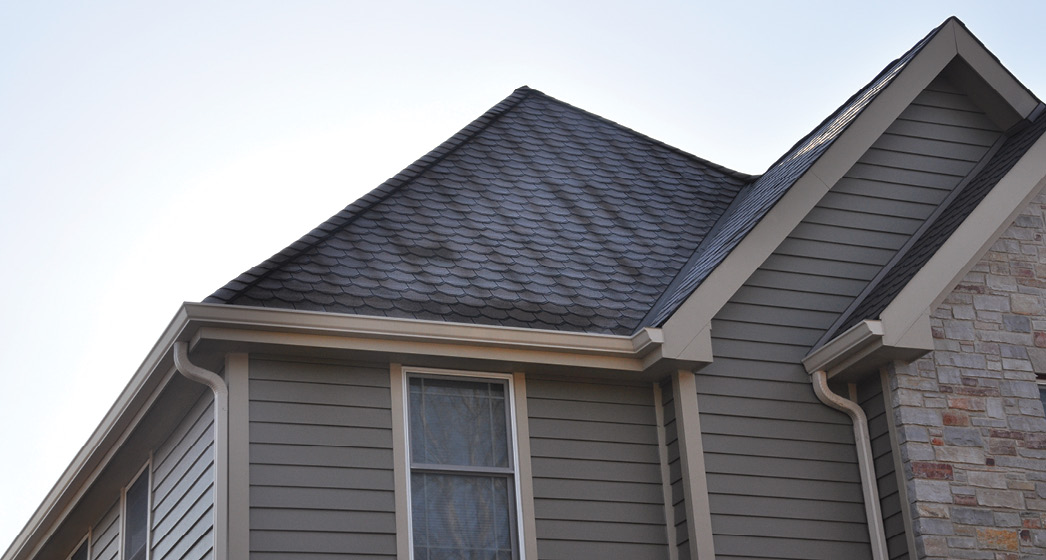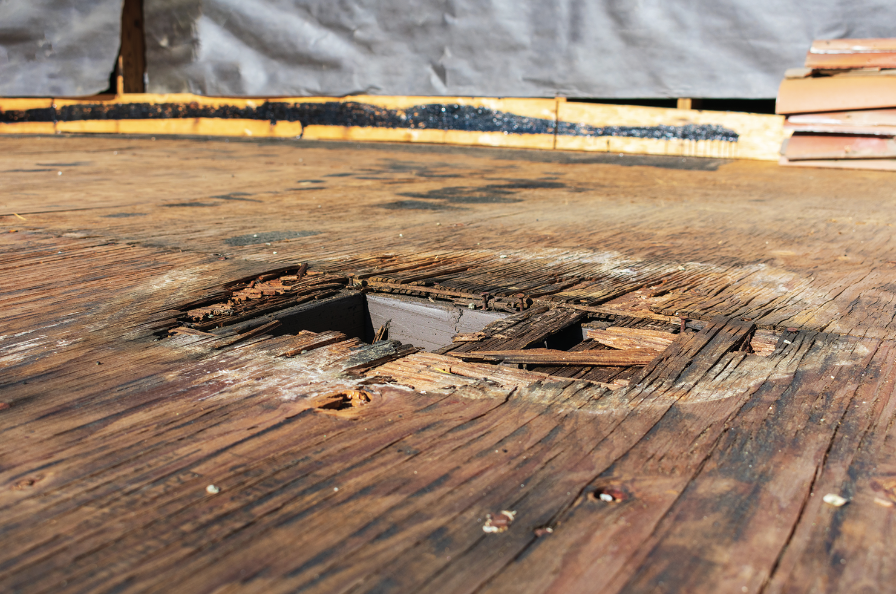Two installers share their thoughts
on 5″, 6″, and 7″ gutters
BY MARK WARD, SR.
They say that football (or whatever your favorite sport) is a “game of inches.” The same might be said about the gutter business.
Gutter machines can be expensive, yet many contractors invest in both 5″ and 6″ models. Why not just stick with one or the other? As it turns out, when discussing gutters, a single inch can make a surprising amount of difference.
Material costs for 6″ seamless gutters are almost double those for 5″ gutters, pointed out owner Julian Korpyta of Carolina Construction in Elk Grove, Illinois. He calculated that one pound of gutter coil yields 2¼’ of 5″ gutter, yet only 1.6′ of 6″ gutter. Labor costs to install 6″ gutters are also “slightly” higher, he added, since his crews need more time to manually miter the larger corners.
Yet 6″ gutters, as compared to 5″, move fully 40% more water, noted President Ryan Grambart of Minneapolis-based CopperSmith Gutter Company. Because higher capacity is the best solution for some projects, he believes gutter contractors benefit from having both 6″ and 5″ gutters in their arsenal of services.
Interestingly, Korpyta and Grambart illustrate very different—yet equally valid—approaches to optimizing gutter size for residential use. “We see 6″ gutters as an upsell opportunity,” explained Korpyta. By contrast, advised Grambart, “Five-inch gutters are fine for most homes, so that our focus is less on the size of the gutter and more on the downspouts.”
An Opportunity to UpSell
As owner of Carolina Construction, Korpyta heads a company that covers northern Illinois from the city of Chicago to the Wisconsin border. [In 2013], seven years since its founding, the business had grown to four crews, including two that install gutters and two that perform roofing and siding projects. “Most of our jobs are for existing homes, though lately we’ve increased the amount of work we do in new construction,” he reported.
Carolina Construction owns three Ironman gutter machines, two that turn out 5″ seamless gutters and one for 6″ projects. The company installs aluminum and copper gutters, obtaining many of its materials from www.guttersupply.com.
With more than 20 years of experience in the gutter business, Korpyta has his numbers down pat. Given that one pound of coil produces 2¼’ of 5″ gutter but only 1.6′ of 6″ gutter, he prices residential jobs accordingly. [At the time of publishing in 2013], Carolina Construction generally installs 5″ gutters at about $3.50 per linear foot and 6″ gutters at $6 or more. The differential includes the added labor of mitering 6″ corners. And since the larger troughs hold more water and get heavier, his crews space hangers every 16″—2″ closer than the spacing for 5″ gutters.
“Even so,” Korpyta continued, “we get a higher profit margin on 6″ gutter jobs.” The reason is that Carolina Construction makes its customer a value proposition rather than a lowball offer. “In our sales,” he explained, “we educate homeowners on what a 5″ gutter can do and what a 6″ gutter can do.”
Over the past generation, Korpyta observed, homes have been increasingly designed with elevations that feature more steeply pitched roofs and more surface area. “That increases water velocity and volume, so that a 5″ gutter trough doesn’t catch it all. But a 6″ trough does the job,” he stated. When Carolina Construction customers decide to replace their gutters, most have reached the point where a solution is more important than just securing the lowest price.
That fact makes 6″ gutters an upsell item for Carolina Construction and a means to increase its profit margins. “In the future,” predicted Korpyta, “I believe more and more customers will go to 6″ gutters, simply because they do a better job of draining water away from today’s homes.”

CopperSmith Gutter Company

CopperSmith Gutter Company
Going With What Works
Ryan Grambart of CopperSmith Gutter Company agreed that, “Six-inch gutters are a good value since the extra money the customer pays buys a lot more water capacity.” But rather than see 6″ gutters as an upsell item over 5″ troughs, he approaches the question as his customers would. “They want ‘what works’ versus ‘overkill,’” he explained.
CopperSmith serves the Minneapolis and St. Paul metro area, and for larger projects has traveled throughout the Midwest. Its three crews install 5″ and 6″ aluminum, steel, and copper gutters. The company owns two New Tech gutter machines and a KWM unit, and obtains supplies from Minnesota-based EDCO Products. While most customers are homeowners, CopperSmith also performs work for the new construction and custom home markets.
“For standard residential homes, 5″ gutters are fine,” advised Grambart. “The size of the gutter is less important than the size of the downspouts, whether the trough is kept clean, and whether the gutter has any leaf protection it may need to cope with the tree cover.” For that reason, CopperSmith often installs 3″ x 4″ downspouts rather than 2″ x 3″ units. Further, Grambart’s company is a market-exclusive dealer for the Gutter Cap leaf protection solution.
At least in the Minnesota market that CopperSmith serves, Grambart cited a solid reason to avoid “overkill” in gutter size. Because 6″ gutters hold 40% more water than 5″ systems, the potential for water to pool in the gutter increases. In turn, more water in the trough boosts the chances for winter ice dams to form that can damage the roof and walls of a home.
Yet there are times when Grambart recommends 6″ gutters. “If the fascia board on a home is fairly large, a 5″ gutter would seem too small by comparison,” he explained. “And if we’re installing copper gutters, it takes a 6″ half-round trough to hold as much water as a 5″ K-style trough.” Then, too, a 6″ gutter may be needed if the slope of the roof is not conducive to good drainage.

Carolina Construction
Finally, the footprint of a particular home may prevent CopperSmith crews from installing as many downspouts as they would prefer. “It’s important to keep water away from entrances, sidewalks, patios, and the like, places where excess water could lead to dangerous ice slicks,” Grambart continued. If the number or placement of such features cuts down available spaces for downspouts, then a larger gutter trough may be warranted. “In those cases,” he said, “a trough that moves more water can help us avoid placing downspouts in problem areas.”

Carolina Construction

Carolina Construction

CopperSmith Gutter Company
When a residential job requires 6″ gutters, Grambart generally boosts his price about 15% to 20% over the cost of a 5″ system. But other than the cases just described, most 6″ gutters installed by CopperSmith are for commercial customers.
Ultimately, Grambart and his team base decisions about gutter size on their many years of experience. “We take what we’ve learned from other companies and then build on that,” he related. “For example, we start with the standard of spacing hangers 2′ apart and then adjust that spacing as needed for a particular job.”
Grambart’s experience has also taught him that the material of a gutter—aluminum, steel, or copper—is a factor in choosing the right size. Imagine trying to “supersize” an aluminum gutter from 5″ to 7″. “Aluminum would be too flimsy for a 7″ gutter,” he said. The very notion, however, illustrates his point. “The bigger your gutter and the more water it holds, the stronger your gutter needs to be,” he stated.

CopperSmith Gutter Company
For that reason, Grambart’s company—despite its CopperSmith name—is moving increasingly toward steel gutters for residential projects. “Gutter machines for running steel are getting better,” he reported, “and there have been some real innovations in paint coatings, both on the outside and the inside of the trough. You can now get 50-year warranties on steel gutters. I think aluminum is on the way out. Even at the same thickness, steel is much stronger.”
The 7″ Solution
Both Korpyta and Grambart put 7″ gutters in an entirely different category than 5″ and 6″ systems. Offering a 7″ option is tantamount to entering the commercial gutter market. Thus, the decision between 5″ and 6″ gutters is a performance and price decision; but by contrast, going to 7″ gutters is a business decision.
Nevertheless, 7″ gutters can be compared to smaller systems by the numbers. Korpyta’s Carolina Construction has occasionally installed 7″ gutters on flat-roofed homes and buildings. He calculates that while 6″ gutters are double the per-foot material costs of 5″ gutters, 7″ systems are triple. And the installed cost is far more.
“We have to buy 7″ gutters in sections of 20′ to 35′,” he explained, “and can’t run them ourselves to the lengths we need. Those sections are heavy, which increases labor time and then our crews have to join all the seams.” Thus, while Carolina Construction charges about $3.50 per linear foot to install 5″ gutters and $6.00 or more for 6″, the price for 7″ gutters starts at about $22.00 per linear foot.
CopperSmith Gutter Company has likewise installed 7″ gutters on occasion for specialized projects. Compared to 5″ gutters, Grambart charges about 15% to 20% more for 6″ gutters—and double for 7″ systems. “The cost is 100% more,” he reported, “because 7″ gutters must be custom-ordered from a supplier or custom-fabricated in our shop. After that, our crews have to spend extra time on the seams.”
A single inch may not seem like much. But between 5″, 6″, and 7″ gutters, size really matters.
A 2021 Update: After several years in the copper gutter business, Ryan Grambart transitioned CopperSmith to focus on custom-order range hoods, bathtubs, fire pits, and more, and is considered a leading online retailer in the market. Julian Korpyta could not be reached for a business update.

















